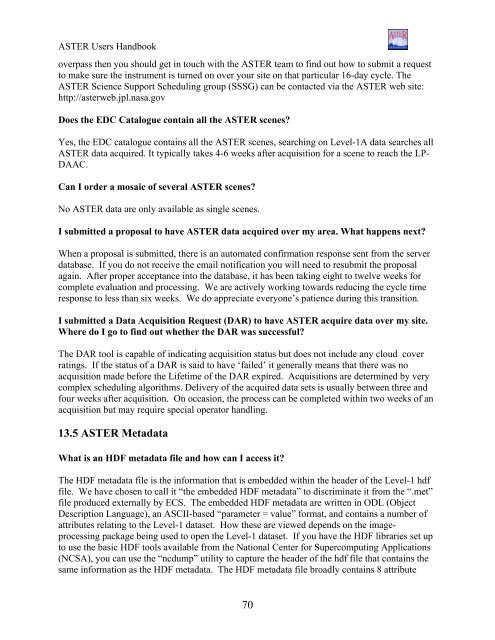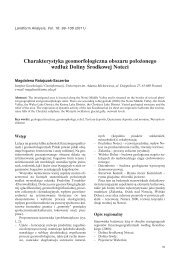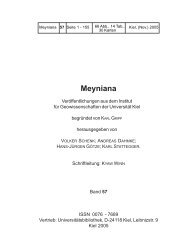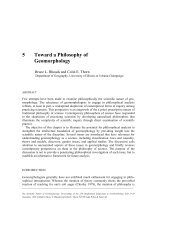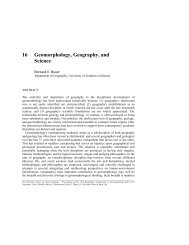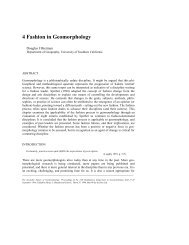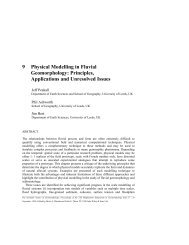ASTER User's Guide - Aster - NASA
ASTER User's Guide - Aster - NASA
ASTER User's Guide - Aster - NASA
Create successful ePaper yourself
Turn your PDF publications into a flip-book with our unique Google optimized e-Paper software.
<strong>ASTER</strong> Users Handbook<br />
overpass then you should get in touch with the <strong>ASTER</strong> team to find out how to submit a request<br />
to make sure the instrument is turned on over your site on that particular 16-day cycle. The<br />
<strong>ASTER</strong> Science Support Scheduling group (SSSG) can be contacted via the <strong>ASTER</strong> web site:<br />
http://asterweb.jpl.nasa.gov<br />
Does the EDC Catalogue contain all the <strong>ASTER</strong> scenes?<br />
Yes, the EDC catalogue contains all the <strong>ASTER</strong> scenes, searching on Level-1A data searches all<br />
<strong>ASTER</strong> data acquired. It typically takes 4-6 weeks after acquisition for a scene to reach the LP-<br />
DAAC.<br />
Can I order a mosaic of several <strong>ASTER</strong> scenes?<br />
No <strong>ASTER</strong> data are only available as single scenes.<br />
I submitted a proposal to have <strong>ASTER</strong> data acquired over my area. What happens next?<br />
When a proposal is submitted, there is an automated confirmation response sent from the server<br />
database. If you do not receive the email notification you will need to resubmit the proposal<br />
again. After proper acceptance into the database, it has been taking eight to twelve weeks for<br />
complete evaluation and processing. We are actively working towards reducing the cycle time<br />
response to less than six weeks. We do appreciate everyone’s patience during this transition.<br />
I submitted a Data Acquisition Request (DAR) to have <strong>ASTER</strong> acquire data over my site.<br />
Where do I go to find out whether the DAR was successful?<br />
The DAR tool is capable of indicating acquisition status but does not include any cloud cover<br />
ratings. If the status of a DAR is said to have ‘failed’ it generally means that there was no<br />
acquisition made before the Lifetime of the DAR expired. Acquisitions are determined by very<br />
complex scheduling algorithms. Delivery of the acquired data sets is usually between three and<br />
four weeks after acquisition. On occasion, the process can be completed within two weeks of an<br />
acquisition but may require special operator handling.<br />
13.5 <strong>ASTER</strong> Metadata<br />
What is an HDF metadata file and how can I access it?<br />
The HDF metadata file is the information that is embedded within the header of the Level-1 hdf<br />
file. We have chosen to call it “the embedded HDF metadata” to discriminate it from the “.met”<br />
file produced externally by ECS. The embedded HDF metadata are written in ODL (Object<br />
Description Language), an ASCII-based “parameter = value” format, and contains a number of<br />
attributes relating to the Level-1 dataset. How these are viewed depends on the imageprocessing<br />
package being used to open the Level-1 dataset. If you have the HDF libraries set up<br />
to use the basic HDF tools available from the National Center for Supercomputing Applications<br />
(NCSA), you can use the “ncdump” utility to capture the header of the hdf file that contains the<br />
same information as the HDF metadata. The HDF metadata file broadly contains 8 attribute<br />
70


